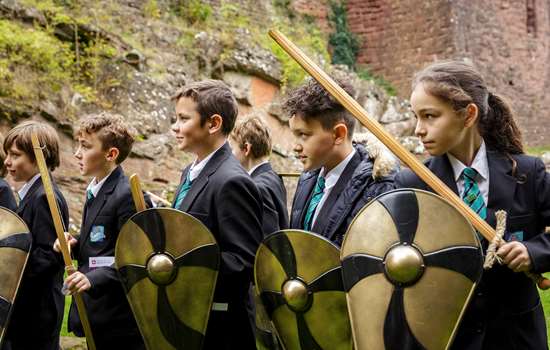Curriculum Links
Support your teaching in the classroom by stepping out of it. A visit to Pickering Castle will help you bring learning to life, covering multiple topics across the curriculum and key stages.
- KS1 History: significant historical events, people and places in the locality
- KS2 History: study of an aspect or theme in British history that extends pupil’s chronological knowledge beyond 1066, a local history study
- KS2 Geography: Types of settlement and land use
- KS3 History: The Development of Church, State and Society in Medieval Britain 1066 – 1509, A local history study
- KS4: Early Medieval History, OCR History A: Study of the Historic Environment, OCR History B: History around us, AQA Section B: British Depth Studies – historic environment and Norman and Medieval England
- KS5 History: OCR unit Y103/Y133; England 1199 – 1272; Edexcel Route A Paper 2, Anglo-Saxon England and the Anglo-Norman Kingdom, c 1053-1106
Free Self-Led Visits
Book a free self-led visit to Pickering Castle and organise your day to suit your curriculum objectives.
Immerse your class in the Norman world as they enter the site through the once well defended gatehouse. They can cross the bailey –the service area for the castle, and then enter the inner ward to ascend the motte to where the keep once stood.
There is a fully reconstructed chapel for you to explore before descending into the ditch around the motte, which gives first-hand experience of the scale of the place. Can your class find the ovens and identify latrine chutes as they look around?
Enquire NowPlan Your Trip
We have a wide range of materials to support your visit and make school trip planning easy. You can find all our site-specific information and tools below, and for Covid-19 risk assessments and measures we’ve got in place please visit our what to expect page.
Download our free resources to help you make the most out of your visit and create unique learning experiences before, during and after your trip. We also offer free planning visits once you have made a booking, plus a 20% discount on the official English Heritage guidebook for your place of choice.
Once you book your visit you’ll be sent a visit permit, which you’ll need to bring with you on the day.
Visit our bookings page to start planning your trip!
Learning Resources
-

Pickering Castle Activity Trail (KS2-KS3)
Explore Pickering Castle with our activity trail and investigate how and why this historic environment changed over time.
-

Pickering Castle Education Room Activities (KS2-3)
Use our guide to the history and STEM-focused activities available in the education room at Pickering Castle to get the most out of your visit.
-

Teaching Anglo-Saxons and Normans
Use historical information, learning activities and tips from our historians, curators and educational experts to support your teaching of the Anglo-Saxons and Normans.
-
A Brief History of the Normans
Learn more about the origins of the Normans, the dispute between Harold Godwinson and William the Conqueror and how the Normans took control of England in this short animation.
-
Harold vs. William - Whose Crown?
Find out why there was a succession crisis in 1066 and whether William of Normandy or Harold Godwinson had a stronger claim to the English throne with this short animation.
-

Teaching Medieval History
Use historical information, learning activities and tips from our historians, curators and educational experts to support your teaching of medieval history.
-
A Mini Guide to Castles
Discover how castles developed over time with this short introduction.
-
How to Take a Medieval Castle
Watch our short animation to learn more about how to take a medieval castle.
-
Enquire now
0370 333 1181
-
Visit our bookings page to start your enquiry. All bookings must be made at least 14 days in advance. Please make sure you check our terms and conditions ahead of your visit.
If you’d like more information about a site or one of our workshops, get in touch using the online form on our bookings page to speak to your local Education Visits Officer. We look forward to seeing you soon.
